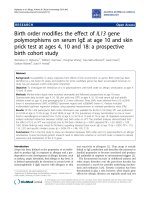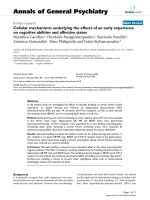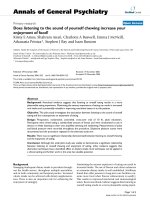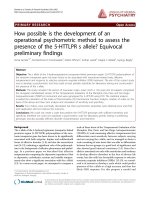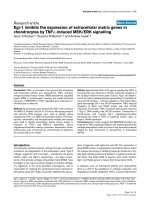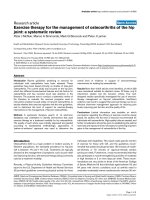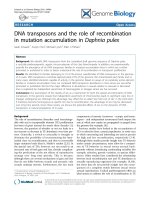Báo cáo y học: "Memory-enhancing treatments reverse the impairment of inhibitory avoidance retention in sepsis-surviving rats" pdf
Bạn đang xem bản rút gọn của tài liệu. Xem và tải ngay bản đầy đủ của tài liệu tại đây (192.41 KB, 6 trang )
Open Access
Available online />Page 1 of 6
(page number not for citation purposes)
Vol 12 No 5
Research
Memory-enhancing treatments reverse the impairment of
inhibitory avoidance retention in sepsis-surviving rats
Lisiane Tuon
1
, Clarissa M Comim
1
, Fabrícia Petronilho
2
, Tatiana Barichello
2
, Ivan Izquierdo
3
,
João Quevedo
1
and Felipe Dal-Pizzol
2
1
Laboratório de Neurociências, Programa de Pós-Graduação Ciências da Saúde, Unidade Acadêmica de Ciências da Saúde, Universidade do
Extremo Sul Catarinense, Av. Universitária, 1105, 88806-000 Criciúma, SC, Brasil
2
Laboratório de Fisiopatologia Experimental, Programa de Pós-Graduação em Ciências da Saúde, Unidade Acadêmica de Ciências da Saúde,
Universidade do Extremo Sul Catarinense, Av. Universitária, 1105, 88806-000 Criciúma, SC, Brasil
3
Centro de Memória, Instituto de Pesquisas Biomédicas, Pontifícia Universidade Católica do Rio Grande do Sul, Av Ipiranga, 6690, 90610-000 Porto
Alegre, RS, Brasil
Corresponding author: Felipe Dal-Pizzol,
Received: 9 Sep 2008 Revisions requested: 30 Sep 2008 Revisions received: 6 Oct 2008 Accepted: 28 Oct 2008 Published: 28 Oct 2008
Critical Care 2008, 12:R133 (doi:10.1186/cc7103)
This article is online at: />© 2008 Tuon et al.; licensee BioMed Central Ltd.
This is an open access article distributed under the terms of the Creative Commons Attribution License ( />),
which permits unrestricted use, distribution, and reproduction in any medium, provided the original work is properly cited.
Abstract
Introduction Survivors from sepsis have presented with long-
term cognitive impairment, including alterations in memory,
attention, concentration, and global loss of cognitive function.
Thus, we evaluated the effects of memory enhancers in sepsis-
surviving rats.
Methods The rats underwent cecal ligation and perforation
(CLP) (sepsis group) with 'basic support' (saline at 50 mL/kg
immediately and 12 hours after CLP plus ceftriaxone at 30 mg/
kg and clindamycin at 25 mg/kg 6, 12, and 18 hours after CLP)
or sham-operated (control group). After 10 or 30 days, rats were
submitted to an inhibitory avoidance task. After task training,
animals received injections of saline, epinephrine, naloxone,
dexamethasone, or glucose. Twenty-four hours afterwards,
animals were submitted to the inhibitory avoidance test.
Results We demonstrated that memory enhancers reversed
impairment in the sepsis group 10 and 30 days after sepsis
induction. This effect was of lower magnitude when compared
with sham animals 10 days, but not 30 days, after sepsis.
Conclusions Using different pharmacologic approaches, we
conclude that the adrenergic memory formation pathways are
responsive in sepsis-surviving animals.
Introduction
Central nervous system dysfunction secondary to sepsis can
occur in 8% to 70% of septic patients [1]. In addition, it has
been demonstrated that survivors from sepsis presented long-
term cognitive impairment, including alterations in memory,
attention, concentration, and global loss of cognitive function
[2]. However, the mechanisms associated with these altera-
tions are still unclear. We had previously demonstrated that
sepsis survivors after 10 and 30 days of cecal ligation and per-
foration (CLP) presented memory impairment and behavior
alterations, and we proposed this model as a useful tool to
determine the mechanisms associated with long-term cogni-
tive impairment in sepsis survivors [3-7].
Aversively motivated learning is influenced by neuromodula-
tors and hormones related to emotional aspects of the training
experience. Emotionally arousing events cause a release of
epinephrine (EPI) and an increase in corticosterone, and both
EPI and corticosteroids are known to modulate memory [8].
Other systems could modulate the formation of emotionally
motivated memory. For example, opioid receptors are involved
in memory modulation, and post-training injections of the opi-
oid antagonist naloxone (NAL) enhance retention of inhibitory
avoidance in rats [9]. In this context, we investigated whether
some of the molecular mechanisms associated with memory
formation are preserved in sepsis survivors using the post-
training administration of EPI, NAL, dexamethasone (DEX),
and glucose (GLU) in a step-down inhibitory avoidance task in
rats.
CLP: cecal ligation and perforation; DEX: dexamethasone; EPI: epinephrine; GLU: glucose; NAL: naloxone.
Critical Care Vol 12 No 5 Tuon et al.
Page 2 of 6
(page number not for citation purposes)
Materials and methods
Animals
Two hundred forty adult male Wistar rats (220 to 300 g) were
obtained from our breeding colony. They were housed five to
a cage with food and water available ad libitum and were main-
tained on a 12-hour light/dark cycle (lights on at 7 a.m.).
Behavioral procedures were conducted between 8 a.m. and
noon. All experimental procedures involving animals were per-
formed in accordance with the National Institutes of Health
Guide for the Care and Use of Laboratory Animals [10] and
the Brazilian Society for Neuroscience and Behavior (SBNeC)
recommendations for animal care, and approval for the study
was given by the ethics committee from our university.
Cecal ligation and perforation surgery
Animals were subjected to CLP as described [11] with adap-
tations [12-14]. Briefly, rats were anesthetized with a mixture
of ketamine (80 mg/kg) and xylazine (10 mg/kg) given intra-
peritoneally. Under aseptic conditions, a 3-cm midline laparot-
omy was performed to allow exposure of the cecum with the
adjoining intestine. The cecum was tightly ligated with a 3.0
silk suture at its base, below the ileocecal valve, and was per-
forated once with a 14-gauge needle. The cecum was then
gently squeezed to extrude a small amount of feces from the
perforation site returned to the peritoneal cavity, and the
laparotomy was closed with 4.0 silk sutures. Animals were
resuscitated with normal saline (50 mL/kg subcutaneously)
immediately and 12 hours after CLP. All animals were returned
to their cages with free access to food and water. In the sham-
operated group, the rats were submitted to all surgical proce-
dures but the cecum was neither ligated nor perforated. After
surgery, the sepsis group received 'basic support' (30 mg/kg
ceftriaxone and 25 mg/kg clindamycin subcutaneously every 6
hours for a total of 3 days). The sham-operated group received
the volume of saline corresponding to antibiotic administra-
tion. Survival rates were 100% in the sham group and 47% in
the sepsis group, which were in accordance with our previous
reports [12-14]. Animals were randomly distributed to sham
and CLP groups and to memory enhancers or saline, and 10
or 30 days after surgery the animals underwent an inhibitory
avoidance test.
Inhibitory avoidance
The inhibitory avoidance procedure was described in a previ-
ous report [15]. The apparatus was an acrylic box (50 × 25 ×
25 cm) whose floor consisted of parallel-caliber stainless-steel
bars (1 mm diameter) spaced 1 cm apart, and a platform that
was 7 cm wide and 2.5 cm high. Animals were placed on the
platform and their latency to step down on the grid with all four
paws was measured with an automatic device. Training ses-
sions were performed 10 or 30 days after surgery. Immediately
after stepping down on the grid, animals received a foot shock
of 0.3 mA and 2 seconds. In test sessions carried out 24 hours
after training, no foot shock was given and the step-down
latency (maximum of 180 seconds) was used as a measure of
retention. The behavioral tests were performed by the same
person that was blind to the experimental group.
Intervention
The animals were divided in groups of 15 and received an
intraperitoneal injection of saline (control), EPI (25 μg/kg),
NAL (0.4 mg/kg), DEX (0.3 mg/kg), or GLU (320 mg/kg)
immediately after training. The doses were selected based on
a previous report [15].
Statistical analyses
Data for inhibitory avoidance are presented as the median
(interquartile range) of retention test latencies. Differences
between training and test session latencies within each group
were determined using the Wilcoxon test. The Kruskal-Wallis
test was performed in comparisons between groups. For com-
parisons between various treatments, the Mann-Whitney test
with the Bonferroni adjustment modified by Finner was used.
Results
As expected, classical memory enhancers EPI (Z = -3.05, P =
0.002 for both 10 and 30 days after surgery, comparing train-
ing and test), NAL (Z = -3.06, P = 0.002 for both 10 and 30
days after surgery, comparing training and test), DEX (Z = -
3.05, P = 0.002 for both 10 and 30 days after surgery, com-
paring training and test), or GLU (Z = -3.06, P = 0.002 for
both 10 and 30 days after surgery, comparing training and
test) improved memory in the inhibitory avoidance 10 and 30
days after sham surgery (Figures 1 and 2). Ten days after CLP,
EPI (Z = -3.18, P = 0.001, comparing training and test), NAL
(Z = -3.06, P = 0.002, comparing training and test), DEX (Z =
-3.06, P = 0.002, comparing training and test), or GLU (Z = -
3.06, P = 0.002, comparing training and test) reversed mem-
ory impairment but this effect was of lower magnitude when
compared with sham animals (Figure 1) (Additional data file 1).
In addition, memory enhancers reversed memory impairment
30 days after sepsis induction in the same magnitude when
compared with sham animals (Z = -3.18, P = 0.001 to EPI,
comparing training and test; Z = -3.06, P = 0.002 to NAL,
comparing training and test; Z = -2.93, P = 0.003 to DEX,
comparing training and test; Z = -3.06, P = 0.002 to GLU,
comparing training and test) (Figure 2) (Additional data file 1).
Discussion
The present study demonstrated that the administration of
memory enhancers (EPI, NAL, DEX, or GLU) in sepsis survi-
vors reverses long-term cognitive impairment. These results
suggest that, instead of the demonstrated neuronal loss after
sepsis [16], the molecular mechanisms associated with affec-
tive memory formation are preserved in sepsis survivors. The
effect of cognitive enhancers seemed to be of a different mag-
nitude 10 or 30 days after sepsis, suggesting that the mecha-
nisms responsible for affective memory formation were more
compromised early after sepsis recovery. This observation is
consistent with our previous results that demonstrated a time-
Available online />Page 3 of 6
(page number not for citation purposes)
dependent recuperation of memory deficits in sepsis-surviving
rats [3-7]. We had previously demonstrated that survivors from
sepsis presented habituation and non-aversive and aversive
memory deficits [3-7], but the results presented here are lim-
ited to aversive (affective) memory, which has several charac-
teristics that are very different than declarative, procedural, or
Figure 1
Inhibitory avoidance task 10 days after cecal ligation and perforation (CLP)Inhibitory avoidance task 10 days after cecal ligation and perforation (CLP). Animals were submitted to CLP or were placed in a sham-operated
group. Ten days after surgery, animals underwent the training test for an inhibitory avoidance task. Immediately after training, animals received a sin-
gle injection of saline (SAL), epineohrine (EPI), naloxone (NAL), dexamethasone (DEX), or glucose (GLU), and animals were tested 24 hours later.
Data are presented as median (interquartile range) of retention test latencies. *Significantly different between training and test, P < 0.05, Wilcoxon
test. **Significantly different between NAL, GLU, EPI, or DEX and SAL in the test section, P < 0.05, Mann-Whitney test (Kruskal-Wallis chi-square
13.4, P = 0.009).
#
Significantly different between sham and CLP in the test section, P < 0.05, Mann-Whitney test (Kruskal-Wallis chi-square 27.48,
P < 0.001).
Figure 2
Inhibitory avoidance task 30 days after cecal ligation and perforation (CLP)Inhibitory avoidance task 30 days after cecal ligation and perforation (CLP). Animals were submitted to CLP or were placed in a sham-operated
group. Thirty days after surgery, animals underwent the training test for an inhibitory avoidance task. Immediately after training, animals received a
single injection of saline (SAL), epineohrine (EPI), naloxone (NAL), dexamethasone (DEX), or glucose (GLU), and animals were tested 24 hours after.
Data are presented as median (interquartile range) of retention test latencies. *Significantly different between training and test, P < 0.05, Wilcoxon
test. **Significantly different between NAL, GLU, EPI, or DEX and SAL in the test section, P < 0.05, Mann-Whitney test (Kruskal-Wallis chi-square
27.7, P < 0.001).
#
Significantly different between sham and CLP in the test section, P < 0.05, Mann-Whitney test (Kruskal-Wallis chi-square 30.8,
P = 0.001).
Critical Care Vol 12 No 5 Tuon et al.
Page 4 of 6
(page number not for citation purposes)
instrumental memory [17].
Several studies have found alterations in neurocognitive func-
tion following critical illness [18-23], and recognition of these
long-term sequelae in survivors from critical illnesses has
shifted outcome values from reduction in hospital mortality to
patient-centered outcomes [24]. However, to date, the mech-
anisms associated with these alterations are still unclear; thus,
animal models can be used to address these limitations.
Explicitly or implicitly, learning tasks in animals involve the per-
formance or the inhibition of some form of movement in
response to sensory or other cues. Of the various training pro-
cedures used, perhaps the most popular in the past few years
have been the Morris water maze, one-trial inhibitory avoid-
ance, and various forms of fear conditioning, all of which
closely mimic human situations of daily life. The inhibitory
avoidance task relies heavily on the dorsal hippocampus but
also depends on the entorhinal and parietal cortex and is mod-
ulated by the amygdale [25,26]. In this way, we believe that
our results, using the CLP model, provide relevant insights into
the mechanisms involved in the cognitive deficits associated
with sepsis and into therapeutic approaches to this problem.
None of the neuropsychological tests that are used in humans,
however, assessed memory of this sort. Rather, cognitive
assessments evaluated patients on measures of, for example,
declarative memory and working memory. Recognition of
objects is thought to be a critical component of human declar-
ative memory that is mainly dependent on the hippocampus.
Object recognition is commonly impaired in human patients
affected by neurodegenerative diseases or who have suffered
brain injury [27,28]. In addition, executive functions are medi-
ated by independent and interacting neural systems that may
be compromised by different forms of pathology, leading to a
range of cognitive profiles. The frontostriatal network mediates
those cognitive functions that are needed to optimize perform-
ance in complex tasks and that include a number of psycho-
logical processes. Recognition memory was previously
demonstrated to be altered in animal models of sepsis [5], but
there were no published data that assessed executive mem-
ory. Therefore, future animal studies that test the effect of crit-
ical illness on cognitive functions should employ outcomes
that assess functioning in homologous systems in animals
involving the frontal lobe and/or hippocampus as is observed
in humans.
All the used memory enhancers seemed to exert their effect by
modulating the adrenergic system, and there is evidence that
catecholamine has profound effects on cognitive function
[29]. Immediate post-training systemic injections of EPI or
norepinephrine enhance the consolidation and/or storage of
novel information in rats [29]. The enhancing effects of gluco-
corticoids on memory consolidation depend on the integrity of
the amygdala noradrenergic system [30] as do the enhancing
effects of NAL [31]. The effects of the noradrenergic system
on memory formation seemed to be dependent on GLU since
a noradrenergic agonist enhances memory formation by facili-
tation of GLU uptake at the time of memory consolidation [32].
These effects are not restricted to animal models. Recent evi-
dence indicates that EPI enhances memory consolidation in
humans [33]. In addition, it is now well established that gluco-
corticoid hormones enhance memory consolidation [34] and
that GLU modulates memory formation in humans [35]. Opioid
peptides mediate alterations in human memory during emo-
tional states and help to explain why memories may be selec-
tively deficient under conditions of stress [36]. Thus, since
survivors from the intensive care unit presented long-term cog-
nitive impairment, including alterations in memory, and this
was associated with a decrease in quality of life [23], our
results brings the perspective to improve long-term outcome
in sepsis survivors.
Some limitations of our study must be pointed out. First, septic
animals in comparison with sham controls received antibiotics,
which could have neuroprotective properties [37]. We had
demonstrated previously that the antibiotics used in our model
did not modify memory performance in our model [4]; thus, we
believe that this limitation is of minor importance. Second, it
would be interesting to examine the effects of other drugs that
are more promising as clinically useful cognitive enhancers
(that is, rolipram) [38], but since this is the first demonstration
of enhancing memory after CLP, we decided to use more
'classical' memory enhancers. Third, only single doses of the
memory enhancers were evaluated; thus, instead of a normal
response observed using these doses, we could not rule out
the possibility that in sepsis survivors the dose response curve
to these enhancers may be altered. Fourth, we demonstrated
that sepsis altered memory of an emotional event (that is, foot
shock). One may suggest that the response to a new stimulus
depends on the intensity of a previous emotional challenge
and that we are not observing a true sepsis effect, but a pro-
cedure-related effect. We tried to avoid this limitation by ran-
domly dividing animals between groups, and animals were
subjected to the same surgical procedure, with sepsis being
the sole difference between groups. There are also some
clues that suggest that animals are similar in regard to stress
response. First, in the open-field task, there were no differ-
ences in the number of crossings and rearings between
groups in the training session, demonstrating no difference in
motor and exploratory activities between groups [3,4], and
stressed animals presented alterations in the exploratory activ-
ity [39]. Second, in analyses at 10 and 30 days after CLP,
sham and septic animals presented no differences in foot
shock sensitivity as assessed by the 'flinch and jump'
response test [40].
Conclusion
We demonstrated, for the first time, using different pharmaco-
logic approaches, that the adrenergic system is responsive in
sepsis-surviving animals in different intensities 10 and 30 days
Available online />Page 5 of 6
(page number not for citation purposes)
after sepsis. Since this system is relevant to memory formation
in humans and animals, our results brings the perspective that
the modulation of the adrenergic system could be a suitable
tool in the treatment of memory deficits observed in sepsis
survivors.
Competing interests
The authors declare that they have no competing interests.
Authors' contributions
LT conceived of this study, participated in the design of the
study, and drafted the manuscript. CMC, FP, and TB partici-
pated in the design of the study and performed experimental
analyses. II, JQ, and FD-P participated in the design of the
study and drafted the manuscript.
Additional files
Acknowledgements
The authors thank CNPq and UNESC for their financial support.
References
1. Sprung CL, Peduzzi PN, Shatney CH, Schein RM, Wilson MF,
Sheagren JN, Hinshaw LB: Impact of encephalopathy on mor-
tality in the sepsis syndrome. The Veterans Administration
Systemic Sepsis Cooperative Study Group. Crit Care Med
1990, 18:801-806.
2. Gordon SM, Jackson JC, Ely EW, Burger C, Hopkins RO: Clinical
identification of cognitive impairment in ICU survivors:
insights for intensivists. Intensive Care Med 2004,
30:1997-2008.
3. Barichello T, Martins MR, Reinke A, Feier G, Ritter C, Quevedo J,
Dal-Pizzol F: Long-term cognitive impairment in sepsis
survivors. Crit Care Med 2005, 33:1671.
4. Barichello T, Martins MR, Reinke A, Feier G, Ritter C, Quevedo J,
Dal-Pizzol F: Cognitive impairment in sepsis survivors from
cecal ligation and perforation. Crit Care Med 2005,
33:221-223.
5. Barichello T, Martins MR, Reinke A, Constantino LS, Machado RA,
Valvassori SS, Moreira JC, Quevedo J, Dal-Pizzol F: Behavioral
deficits in sepsis-surviving rats induced by cecal ligation and
perforation. Braz J Med Biol Res 2007, 40:831-837.
6. Tuon L, Comim CM, Antunes MM, Constantino LS, Machado RA,
Izquierdo I, Quevedo J, Dal-Pizzol F: Imipramine reverses the
depressive symptoms in sepsis survivor rats. Intensive Care
Med 2007, 33:2165-2167.
7. Barichello T, Machado RA, Constantino L, Valvassori SS, Reus
GZ, Martins MR, Petronilho F, Ritter C, Quevedo J, Dal-Pizzol F:
Antioxidant treatment prevented late memory impairment in
an animal model of sepsis. Crit Care Med 2007,
35:2186-2190.
8. McGaugh JL: Dissociating learning and performance: drug and
hormone enhancement of memory storage. Brain Res Bull
1989, 23:339-345.
9. Cahill L, McGaugh JL: Modulation of memory storage. Curr
Opin Neurobiol 1996, 6:237-242.
10. Institute of Laboratory Animal Resources, Commission on Life Sci-
ences, National Research Council: Guide for the Care and Use of
Laboratory Animals National Academy Press Washington, D.C;
1996.
11. Wichterman KA, Baue AE, Chaudry IH: Sepsis and septic shock-
a review of laboratory models and a proposal. J Surg Res
1980,
29:189-199.
12. Ritter C, Andrades ME, Reinke A, Menna-Barreto S, Moreira JCF,
Dal-Pizzol F: Treatment with N-acetylcysteine plus deferoxam-
ine protects rats against oxidative stress and improves sur-
vival in sepsis. Crit Care Med 2004, 32:342-349.
13. Ritter C, Andrades M, Frota ML Junior, Pinho RA, Moreira JCF, Dal-
Pizzol F: Oxidative parameters and mortality in sepsis induced
by cecal ligation and perforation. Intensive Care Med 2003,
29:1782-1789.
14. Andrades M, Ritter C, Moreira JC, Dal-Pizzol F: Oxidative param-
eters differences during non-lethal and lethal sepsis
development. J Surg Res 2005, 125:68-72.
15. Roesler R, Vianna MR, de-Paris F, Quevedo J: Memory-enhanc-
ing treatments do not reverse the impairment of inhibitory
avoidance retention induced by NMDA receptor blockade.
Neurobiol Learn Mem 1999, 72:252-258.
16. Semmler A, Frisch C, Debeir T, Ramanathan M, Okulla T, Klock-
gether T, Heneka MT: Long-term cognitive impairment, neuro-
nal loss and reduced cortical cholinergic innervation after
recovery from sepsis in a rodent model. Exp Neurol 2007,
204:733-740.
17. LeDoux JE: Emotion circuits in the brain. Annu Rev Neurosci
2000, 23:155-184.
18. Hopkins RO, Jackson JC: Long-term neurocognitive function
after critical illness. Chest 2006, 130:869-878.
19. Granja C, Dias C, Costa-Pereira A, Sarmento A: Quality of life of
survivors from severe sepsis and septic shock may be similar
to that of others who survive critical illness. Crit Care 2004,
8:R91.
20. Hopkins RO, Weaver LK, Collingridge D, Parkinson RB, Chan KJ,
Orme JF Jr: Two-year cognitive, emotional, and quality-of-life
outcomes in acute respiratory distress syndrome. Am J Respir
Crit Care Med 2005, 17:340-347.
21. Angus DC, Musthafa AA, Clermont G, Griffin MF, Linde-Zwirble
WT, Dremsizov TT, Pinsky MR: Quality-adjusted survival in the
first year after the acute respiratory distress syndrome. Am J
Respir Crit Care Med 2001,
163:1389-1394.
22. Hopkins RO, Weaver LK, Chan KJ, Orme JF Jr: Quality of life,
emotional, and cognitive function following acute respiratory
distress syndrome. J Int Neuropsychol Soc 2004,
10:1005-1017.
23. Rothenhausler HB, Ehrentraut S, Stoll C, Schelling G, Kapfham-
mer HP: The relationship between cognitive performance and
employment and health status in long-term survivors of the
acute respiratory distress syndrome: results of an exploratory
study. Gen Hosp Psychiatry 2001, 23:90-96.
24. Rubenfeld GD, Angus D, Pinsky MR, Randall Curtis J, Connors AF,
Bernard GR, the Members of the Outcomes Research Workshop:
Outcomes research in critical care: results of the American
Thoracic Society Critical Care Assembly Workshop on Out-
comes Research. Am J Respir Crit Care Med 1999,
160:358-367.
25. Izquierdo I, Medina JH: Correlation between the pharmacology
of long-term potentiation and the pharmacology of memory.
Neurobiol Learn Mem 1995, 63:19-32.
Key messages
• The administration of memory enhancers in sepsis survi-
vors reverses long-term cognitive impairment.
• The adrenergic system could be pharmacologically
modulated in sepsis-surviving animals being a target in
the future treatment of cognitive impairment in sepsis
survivors.
The following Additional files are available online:
Additional file 1
The following additional data are available with the online
version of this paper. Additional data file 1 is a table
showing the absolute retention values for each group.
See />supplementary/cc7103-S1.doc
Critical Care Vol 12 No 5 Tuon et al.
Page 6 of 6
(page number not for citation purposes)
26. Izquierdo I, Medina JH: Memory formation: the sequence of bio-
chemical events in the hippocampus and its connection to
activity in other brain structures. Neurobiol Learn Mem 1997,
68:285-316.
27. Reed JM, Squire LR: Impaired recognition memory in patients
with lesions limited to the hippocampal formation. Behav
Neurosci 1997, 111:667-675.
28. Laatu S, Revonsuo A, Jaykka H, Portin R, Rinne JO: Visual object
recognition in early Alzheimer's disease: deficits in semantic
processing. Acta Neurol Scand 2003, 108:82-89.
29. McGaugh JL, Roozendaal B: Role of adrenal stress hormones in
forming lasting memories in the brain. Curr Opin Neurobiol
2002, 12:205-210.
30. Quirarte GL, Roozendaal B, McGaugh JL: Glucocorticoid
enhancement of memory storage involves noradrenergic acti-
vation in the basolateral amygdale. Proc Natl Acad Sci USA
1997, 94:14048-14053.
31. Introini-Collison IB, Nagahara AH, McGaugh JL: Memory
enhancement with intra-amygdala post-training naloxone is
blocked by concurrent administration of propranolol. Brain
Res 1989, 476:94-101.
32. Gibbs ME, Summers RJ: Effects of glucose and 2-deoxyglucose
on memory formation in the chick: interaction with beta(3)-
adrenoceptor agonists. Neuroscience 2002, 114:69-79.
33. Cahill L, Alkire MT: Epinephrine enhancement of human mem-
ory consolidation interaction with arousal at encoding. Neuro-
biol Learn Mem 2003, 79:194-198.
34. Roozendaal B: Glucocorticoids and the regulation of memory
consolidation. Psychoneuroendocrinology 2000, 25:213-238.
35. Messier C, Desrochers A, Gagnon M: Effect of glucose, glucose
regulation, and work imagery value on human memory. Behav
Neurosci 1999, 113:431-438.
36. Katzen-Perez KR, Jacobs DW, Lincoln A, Ellis RJ: Opioid block-
ade improves human recognition memory following physio-
logical arousal. Pharmacol Biochem Behav 2001, 70:
77-84.
37. Rothstein JD, Patel S, Regan MR, Haenggeli C, Huang YH, Ber-
gles DE, Jin L, Dykes Hoberg M, Vidensky S, Chung DS, Toan SV,
Bruijn LI, Su ZZ, Gupta P, Fisher PB: Beta-lactam antibiotics
offer neuroprotection by increasing glutamate transporter
expression. Nature 2005, 433:73-77.
38. Rose GM, Hopper A, De Vivo M, Tehim A: Phosphodiesterase
inhibitors for cognitive enhancement. Curr Pharm Des 2005,
11:3329-3334.
39. Grønli J, Murison R, Fiske E, Bjorvatn B, Sørensen E, Portas CM,
Ursin R: Effects of chronic mild stress on sexual behavior,
locomotor activity and consumption of sucrose and saccha-
rine solutions. Physiol Behav 2005, 84:571-577.
40. Tuon L, Comim CM, Petronilho F, Barichello T, Izquierdo I,
Quevedo J, Dal-Pizzol F: Time-dependent behavioral recovery
after sepsis in rats. Intensive Care Med 2008, 34:1724-1731.

